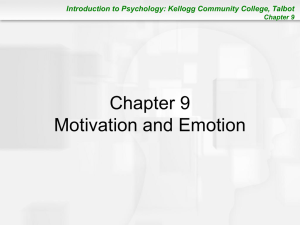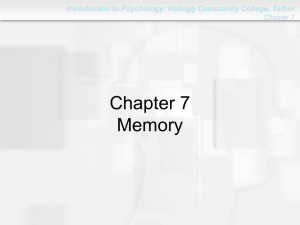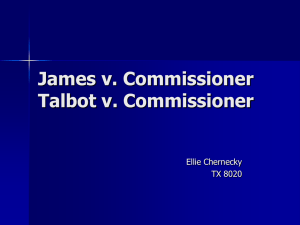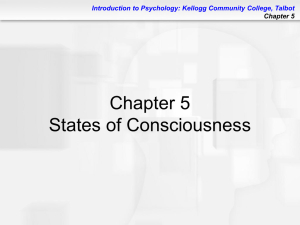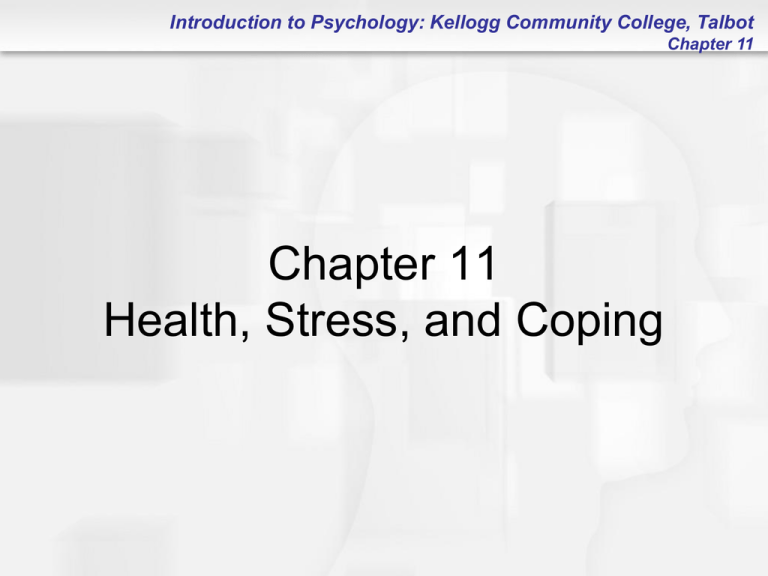
Introduction to Psychology: Kellogg Community College, Talbot
Chapter 11
Chapter 11
Health, Stress, and Coping
Introduction to Psychology: Kellogg Community College, Talbot
Chapter 11
Health Psychology and Behavioral Risk Factors
• Health Psychology: Uses behavioral principles to
prevent illness and promote health
– Behavioral Medicine: Applies psychology to manage
behavioral problems
– Lifestyle Diseases: Diseases related to healthdamaging personal habits
– Behavioral Risk Factors: Behaviors that increase the
chances of disease, injury, or premature death
– Disease-Prone Personality: Personality type
associated with poor health; person tends to be
chronically depressed, anxious, and hostile
Introduction to Psychology: Kellogg Community College, Talbot
Chapter 11
Ways to Promote Health
• Refusal Skills Training: Program that teaches young
people how to resist pressures to begin smoking
• Life Skills Training: Teaches stress reduction, selfprotection, decision making, self-control, and social skills
• Wellness: Positive state of good health and well-being
Introduction to Psychology: Kellogg Community College, Talbot
Chapter 11
Stress
• Mental and physical condition that occurs when a person
must adjust or adapt to the environment
– Includes marital and financial problems
– Eustress: Good stress (e.g., travel, dating)
– Distress
• Stress Reaction: Physical response to stress
– Autonomic Nervous System is aroused
• Stressor: Condition or event that challenges or threatens
the person
• More damaging when considered__________________
• Intensified when perceived as a ___________________
Introduction to Psychology: Kellogg Community College, Talbot
Chapter 11
Burnout
• Prolonged, stress can lead to burnout.
• Burnout: Job-related condition (usually in helping
professions) of physical, mental, and emotional
exhaustion. Has three aspects:
– Emotional Exhaustion: Feel “used up” and “empty”
– Cynicism or detachment from others
– Feeling of reduced personal accomplishment
Introduction to Psychology: Kellogg Community College, Talbot
Chapter 11
Appraising Stressors
• Primary Appraisal: Deciding if a situation is relevant or
irrelevant, positive or threatening
• Secondary Appraisal: Deciding how to cope with a threat
or challenge
• Perceived lack of control is just as threatening as an
actual lack of control
Introduction to Psychology: Kellogg Community College, Talbot
Chapter 11
Threats and Frustration
• Problem-Focused Coping: Managing or altering the
distressing situation
• Emotion-Focused Coping: Trying to control one’s
emotional reactions to the situation
• Frustration: Negative ________ state that occurs when
one is prevented from reaching desired _________.
– External Frustration: Based on external conditions
that impede progress toward a goal
– Personal Frustration: Caused by personal
characteristics that impede progress toward a goal
Introduction to Psychology: Kellogg Community College, Talbot
Chapter 11
Reactions to Frustration
•
•
•
•
Persistence
More vigorous responding
Circumvention
Aggression: Any response made with the intention of
doing harm
• Displaced Aggression: Redirecting aggression to a target
other than the source of one’s frustration
• Scapegoating: Blaming a person or group for conditions
they did not create; the scapegoat is a habitual target of
displaced aggression
• Escape: May mean actually leaving a source of
frustration (dropping out of school) or psychologically
escaping (apathy)
Introduction to Psychology: Kellogg Community College, Talbot
Chapter 11
Conflicts
• A stressful condition that occurs when a person
must choose between contradictory needs,
desires, motives, or demands
• Avoidance-Avoidance Conflicts:
• Appraoch-Approach Conflicts:
• Approach-Avoidance Conflicts:
• Double Approach-Avoidance Conflicts:
– Vacillation: When one is attracted to both choices;
seeing the positives and negatives of both choices
and going “back and forth” before deciding, if deciding
at all!
• Multiple Approach-Avoidance Conflicts:
Introduction to Psychology: Kellogg Community College, Talbot
Chapter 11
Anxiety
• Feelings of tension, uneasiness, apprehension, worry,
and vulnerability
– We are motivated to avoid experiencing anxiety
Introduction to Psychology: Kellogg Community College, Talbot
Chapter 11
Freudian Defense Mechanisms:
Psychological Defenders of You!
• Defense Mechanisms: Habitual and unconscious (in
most cases) psychological processes designed to
reduce anxiety
– Work by avoiding, denying, or distorting sources of
threat or anxiety
– If used short term, can help us get through everyday
situations
– If used long term, we may end up not living in reality
– Protect idealized self-image so we can live with
ourselves
Introduction to Psychology: Kellogg Community College, Talbot
Chapter 11
Freudian Defense Mechanisms:
Some Examples
•
•
•
•
•
•
•
•
•
Denial: Most primitive;
Fantasy
Intellectualization
Isolation
Repression:
Projection:
Rationalization:
Reaction Formation:
Regression
Introduction to Psychology: Kellogg Community College, Talbot
Chapter 11
Learned Helplessness (Seligman)
• Acquired (learned) inability to overcome obstacles and
avoid aversive stimuli; learned passivity
– Occurs when events appear to be uncontrollable
– May feel helpless if failure is attributed to lasting,
general factors
Introduction to Psychology: Kellogg Community College, Talbot
Chapter 11
Depression
• State of feeling despondent defined by feelings of
powerlessness and hopelessness
– One of the most common mental problems in the
world
– Childhood depression is dramatically increasing
– Some symptoms: Loss of appetite or sex drive,
decreased activity, sleeping too much
• Mastery Training: Responses are reinforced that lead to
mastery of a threat or control over one’s environment
– One method to combat learned helplessness and
depression
Introduction to Psychology: Kellogg Community College, Talbot
Chapter 11
How to Recognize Depression (Beck)
• You have a consistently negative opinion of yourself.
• You engage in frequent self-criticism and self-blame.
• You place negative interpretations on events that usually
would not bother you.
• The future looks grim.
• You can’t handle your responsibilities and feel
overwhelmed.
Suicide –
Ideations
Gestures
Serious Attempts
Introduction to Psychology: Kellogg Community College, Talbot
Chapter 11
Immunity (Similar to “Survivor?”)
• Immune System: Mobilizes bodily defenses like white
blood cells against invading microbes and other
diseases
• Psychoneuroimmunology: Study of connections among
behavior, stress, disease, and immune system
Introduction to Psychology: Kellogg Community College, Talbot
Chapter 11
Stress Management
• Use of behavioral strategies to reduce stress and
improve coping skills
• Progressive Relaxation: Produces deep relaxation
throughout the body by tightening all muscles in an area
and then relaxing them
• Guided Imagery: Visualizing images that are calming,
relaxing, or beneficial
Introduction to Psychology: Kellogg Community College, Talbot
Chapter 11
Stress Management (cont'd)
• Stress Inoculation: Using positive coping statements
internally to control fear and anxiety; designed to
combat:
– Negative Self-Statements: Self-critical thoughts that
increase anxiety and lower performance
• Coping Statements: Reassuring, self-enhancing
statements used to stop negative self-statements
Introduction to Psychology: Kellogg Community College, Talbot
Chapter 11
Chapter 12
Psychological Disorders
Introduction to Psychology: Kellogg Community College, Talbot
Chapter 11
What is Normal?
• Psychopathology: Scientific study of mental, emotional,
and behavioral disorders
Normality takes into account 3 things:
• Subjective Discomfort: Feelings of discomfort,
unhappiness, or emotional distress
• Statistical Abnormality: Having extreme scores on some
dimension, such as intelligence, anxiety, or depression
• Social Nonconformity: Disobeying societal standards for
normal conduct; usually leads to destructive or selfdestructive behavior
Introduction to Psychology: Kellogg Community College, Talbot
Chapter 11
What Is Normal? (cont'd)
• Situational Context: Social situation, behavioral setting,
or general circumstances in which behavior takes place
• Cultural Relativity: Judgments are made relative to the
values of one’s culture
Introduction to Psychology: Kellogg Community College, Talbot
Chapter 11
Clarifying and Defining Abnormal Behavior
(Mental Illness)
Maladaptive Behavior: Behavior that makes it difficult to
function, to adapt to the environment, and to meet
everyday demands
Mental Disorder: Significant impairment in psychological
functioning
DSM – IV – TR (Diagnostic Statistical
Manual of Mental Disorders)
Mental Disorders v. Insanity
Introduction to Psychology: Kellogg Community College, Talbot
Chapter 11
Insanity
• Definition: A legal term; refers to an inability to manage
one’s affairs or to be unaware of the consequences of
one’s actions
– Those judged insane (by a court of law) are not held
legally accountable for their actions
– Can be involuntarily committed to a psychiatric
hospital
– Many movements today are trying to abolish the
insanity plea and defense; desire to make everyone
accountable for their actions
– How accurate is the judgment of insanity?
Introduction to Psychology: Kellogg Community College, Talbot
Chapter 11
Clarifying and Defining Abnormal Behavior
(Mental Illness) (cont'd)
• Psychotic Disorder: Severe psychiatric disorder
characterized by hallucinations and delusions, social
withdrawal, and a move away from reality
• Organic Mental Disorder: Mental or emotional problem
caused by brain pathology (i.e., brain injuries or
diseases)
• Mood Disorder: Disturbances in affect (emotions), like
depression or mania
• Anxiety Disorder: Feelings of fear, apprehension,
anxiety, and distorted behavior
Introduction to Psychology: Kellogg Community College, Talbot
Chapter 11
Clarifying and Defining Abnormal Behavior
(Mental Illness) (cont'd)
• Somatoform Disorder: Physical symptoms that mimic
disease or injury (blindness, anesthesia) for which there
is no identifiable physical cause
• Dissociative Disorder: Temporary amnesia, multiple
personality, or depersonalization (like being in a dream
world, feeling like a robot, feeling like you are outside of
your body)
• Personality Disorder: Deeply ingrained, unhealthy,
maladaptive personality patterns
• Sexual and Gender Identity Disorder: Problems with
sexual identity, deviant sexual behavior, or sexual
adjustment
Introduction to Psychology: Kellogg Community College, Talbot
Chapter 11
Clarifying and Defining Abnormal Behavior
(Mental Illness) Concluded
• Substance Related Disorders: Abuse or dependence on
a mind or mood-altering drug, like alcohol or cocaine
– Person cannot stop using the substance and may
suffer withdrawal symptoms if they do
• Neurosis: Archaic; once used to refer to excessive
anxiety, somatoform, dissociative disorders, and some
kinds of depression
Introduction to Psychology: Kellogg Community College, Talbot
Chapter 11
Specific Phobias
• Irrational, persistent fears, anxiety, and avoidance that
focus on specific objects, activities, or situations
• People with phobias realize that their fears are
unreasonable and excessive, but they cannot control
them.
Introduction to Psychology: Kellogg Community College, Talbot
Chapter 11
Social Phobia
• Intense, irrational fear of being observed, evaluated,
humiliated, or embarrassed by others (e.g., shyness,
eating, or speaking in public)
Introduction to Psychology: Kellogg Community College, Talbot
Chapter 11
Obsessive-Compulsive Disorder (OCD)
• Extreme preoccupation with certain thoughts and
compulsive performance of certain behaviors
• Obsession: Recurring images or thoughts that a person
cannot prevent
– Cause anxiety and extreme discomfort
– Enter into consciousness against the person’s will
– Most common: Being dirty or wondering if you
performed an action (turned off the stove)
Introduction to Psychology: Kellogg Community College, Talbot
Chapter 11
Compulsions
• Compulsion: Irrational acts that person feels compelled
to repeat against his/her will
– Help to control anxiety created by obsessions
– Checkers and cleaners
Introduction to Psychology: Kellogg Community College, Talbot
Chapter 11
Schizophrenia:
The Most Severe Mental Illness
• Psychotic disorder characterized by hallucinations,
delusions, apathy, thinking abnormalities, and “split”
between thoughts and emotions
– Does NOT refer to having split or multiple
personalities

